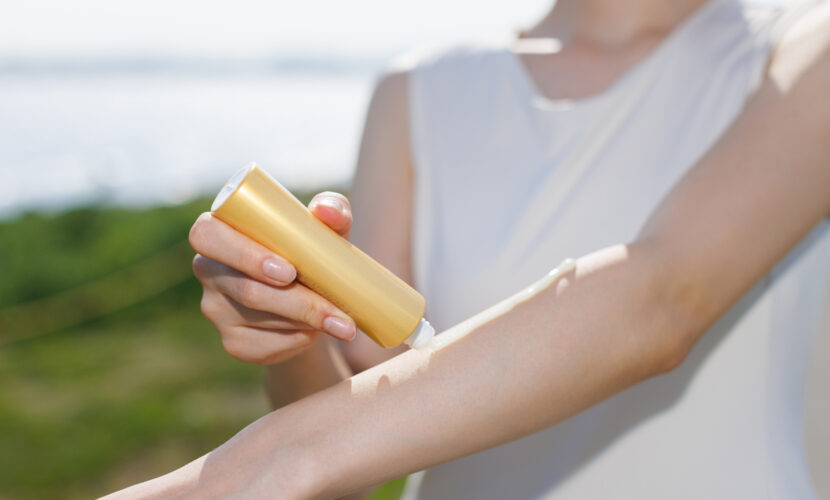紫外線は私たちの肌に深刻な影響を及ぼし、最悪な場合は皮膚がんや早期老化のリスクを高めます。日差しの下での活動は避けられないため、日焼け止めの使用は肌を守るために非常に重要です。しかし、ただ使えばいいというものではありません。
正しい知識と使用法が、紫外線からの保護を最大限に引き出します。ここでは、日焼け止めの選び方から正しい使い方まで、あなたの肌を守るための全てを解説します。

国立熊本大学医学部を卒業。国内大手美容クリニックなどで院長を歴任し、2023年アラジン美容クリニックを開院。長年の実績とエイジングケア研究で博士号取得の美容医療のプロ。「嘘のない美容医療の実現へ」をモットーに、患者様とともに「オンリーワン」を目指す。
日焼け止めの基礎知識!SPFとPAの意味とその重要性

日焼け止め選びにおいて最も基本的な要素が、SPF(Sun Protection Factor)とPA(Protection Grade of UVA)です。これらは、肌を紫外線から守る効果の強さを示す指標であり、適切な製品選びのためには欠かせない情報です。
SPFとは?
SPFは主にUVB(日焼けの原因となる紫外線)からの保護を示します。数値が高いほど保護効果が高く、例えばSPF30なら約30倍の時間、日焼けを遅らせることができるとされています。しかし、SPF値が高いものは肌への負担も大きくなり得るため、日常使いではSPF30~50が推奨されます。
PAとは?
PAはUVA(肌の老化の原因となる紫外線)からの保護を示し、”+”の数で保護レベルが表されます(例:PA+++)。UVAは皮膚深部にダメージを与えるため、早期老化を防ぐには高PA値の製品を選ぶことが重要です。
化学的日焼け止めと物理的日焼け止め
日焼け止めは大きく分けて、化学的日焼け止めと物理的日焼け止めの二つに分類されます。化学的日焼け止めは、紫外線を吸収し、それを熱や他のエネルギー形式に変換することで肌を保護します。肌に塗布した際に透明になりやすく、使用感が軽いのが特徴です。しかし、敏感肌の人には刺激となることがあります。
一方、物理的日焼け止めは、紫外線を反射または散乱させるミネラル(酸化亜鉛や二酸化チタンなど)を含みます。敏感肌やアトピー肌の方にもおすすめされることが多く、化学的日焼け止めに比べると肌への負担が少ないと言われています。ただし、白浮きすることがあるため、塗布時には丁寧になじませる必要があります。
肌タイプ別で見る日焼け止めの選び方

日焼け止め選びにおいて、肌タイプを考慮することは非常に重要です。敏感肌、乾燥肌、脂性肌など、異なる肌タイプにはそれぞれ最適な日焼け止めがあります。ここでは、各肌タイプに適した日焼け止めの選び方を詳しく解説します。
敏感肌の方へのおすすめ
敏感肌の方は、肌に優しい物理的日焼け止めがおすすめです。物理的日焼け止めは、紫外線を物理的にブロックして反射させるミネラル成分(主に酸化亜鉛や二酸化チタン)が含まれています。これらの成分は、肌に対して非常にマイルドで、紫外線吸収剤による刺激が少ないため、敏感肌に適しています。
敏感肌用の日焼け止めを選ぶ際には、無香料、無着色、パラベンフリー、アルコールフリーなど、肌への刺激が少ない製品を選びましょう。また、アレルギーテスト済みや敏感肌用と記載されている製品を選ぶことが望ましいです。
乾燥肌の方へのおすすめ
乾燥肌の方には、ヒアルロン酸、セラミド、グリセリンなどの保湿成分が含まれた日焼け止めが適しています。これらの成分は肌に潤いを与え、紫外線から守りながらも乾燥を防ぎます。特に、クリームタイプの日焼け止めは、その保湿効果により乾燥肌に適していると言えます。
乾燥肌の方は、製品が肌にしっかりと密着し、潤いを長時間保持するタイプを選ぶことが重要です。ウォーターレジスタントタイプの製品は、汗や水による流出を防ぎつつ、肌の潤いを保持するのに役立ちます。
脂性肌の方へのおすすめ
脂性肌の方には、ジェルタイプやミルクタイプのさらっとした使用感の日焼け止めが最適です。これらの製品は、重たくないテクスチャーで肌にすぐに吸収され、肌表面のテカリを抑えます。オイルフリーで、ノンコメドジェニック(非アクネ原性)を謳っている製品を選ぶことで、毛穴の詰まりを防ぎながら紫外線対策ができます。
皮脂吸収成分(例ええばシリカやコーンスターチ)を含む日焼け止めは、脂性肌における余分な皮脂を効果的に吸収し、肌をサラサラに保つ助けとなります。これらの成分が含まれる製品を選ぶことで、日中のテカリを抑え、快適に過ごすことが可能になります。
使用上の注意点とは?
どの肌タイプにも共通して言えることですが、日焼け止めを選ぶ際は、使用上の注意をよく読み、製品の適切な使用方法を守ることが重要です。
日焼け止めは定期的に塗り直しをすることで、その効果を最大限に発揮します。また、日焼け止めの使用だけでなく、帽子やサングラス、日傘など、物理的な紫外線対策と組み合わせることも、効果的な紫外線防御策となります。
正しい日焼け止めの使い方とは?

日焼け止めの正しい使用方法を理解することは、選び方同様に肌を紫外線の害から守る上で非常に重要です。使用量の目安、塗り直しのタイミング、顔と体での適用の違い、さらにメイクアップとの組み合わせ方について、詳しく解説します。
使用量の目安
顔に対する使用量では、目安として小さじ1/4の量(1円玉2枚ほど)が推奨されています。この量はSPFのテストに用いられる量でありますが、使用する物によっては使用量が変わりますので、よく説明を読むことを意識しましょう。仮に、資料量が足りない場合、製品に表示されたSPFの保護効果を得ることができないかもしれません。
また、顔以外の体に対する使用量に関しては、体全体に必要な部位に使うことで使用量が変わってきますが、腕と足で約10ml~20mlが目安です。特に、夏場の日焼けをしやすい部位には必要に応じて量を調整してしっかりと塗布することが重要です。
塗り直しのタイミング
一般的に、日焼け止めは約2時間ごとに塗り直すことが推奨されます。特に水や汗で流れやすいため、水辺での活動やスポーツを行う際は、さらに頻繁に塗り直す必要があります。
特別な状況として、海やプールで泳いだ後や、タオルで体を拭いた後も、たとえウォーターレジスタント製品であっても、塗り直しを行うことが重要です。
顔と体での適用の違い
市販されている日焼け止めには顔専用と体専用の製品があります。顔用製品は、皮脂分泌が多い顔の肌質に合わせて作られており、メイクの下地として使用しやすい特性があります。特に敏感肌用の選択では、肌に優しい成分を使用している製品を選ぶことが望ましいです。
日焼け止めの使用とメイクアップの組み合わせ
日焼け止めはメイクアップの下地としても機能します。メイクをする前に日焼け止めを塗り、肌に完全になじませてからファンデーションを塗ることが推奨されます。
また、日焼け止め成分が含まれる化粧品も有効ですが、これらだけに頼らず、通常の日焼け止めを併用することが理想的です。メイク上からの塗り直しには、スプレータイプやパウダータイプの日焼け止めが便利で、メイクを崩さずに紫外線対策を強化できます。
日焼け止め以外の紫外線対策とは?

紫外線から肌を守るためには、日焼け止めだけではなく、様々な対策を講じることが重要です。ここでは、日焼け止め以外の効果的な紫外線対策方法を詳しくご紹介します。
日焼け止め衣服の使用
特殊な加工が施された日焼け止め衣服は、紫外線保護指数(UPF)が表示され、その数値は衣服が紫外線をどれだけブロックできるかを示しています。
UPF30以上の衣服を選ぶと、紫外線から肌を効果的に守ることができます。軽くて通気性が良い素材を選べば、暑い日でも快適に過ごせます。
帽子とサングラスの使用
顔や頭皮への直接的な紫外線の影響を減らすために、帽子の着用が推奨されます。特につばが広い帽子は、顔だけでなく首や耳への紫外線の影響も軽減します。
また、目や目の周りの皮膚を保護するために、UVカット機能のあるサングラスの着用も重要です。サングラスは目の健康を守るだけでなく、紫外線による目の周りの皮膚の老化防止にも役立ちます。
日陰の利用したり紫外線の強い時間帯を避ける
当然ですが、直射日光を避けるためにできるだけ日陰を利用することが効果的です。特に紫外線が強い時間帯には、日陰で過ごす、または屋内にいることで紫外線曝露を大きく減らすことができます。屋外イベントやアクティビティでは、パラソルや日傘の使用も良い選択肢です。
また、紫外線の強さは一日の中で変化し、特に午前10時から午後2時の間は最も紫外線が強くなります。この時間帯に外出する場合は、上記の対策を徹底するか、可能であれば屋内で過ごすことをおすすめします。
美容皮膚科の施術による紫外線対策
美容医療や美容皮膚の分野での紫外線対策は、日焼け止め以外にも、さまざまなアプローチがあります。これらの対策は、肌の老化防止、色素沈着の予防、また施術後の肌を守るために特に重要です。
たとえば、長年の紫外線露出によるシミ対策レーザー治療と光療法が挙げられます。IPL治療は、日焼けによる色素沈着や赤ら顔、細かい血管の拡張などを改善するのに効果的です。光エネルギーを利用して、特定の肌の問題をターゲットにします。また、肌の再生を促進し、日焼けによるダメージや細かいしわ、色素沈着を改善する治療もできるため、肌の表面だけでなく、深い層のコラーゲン生成を促すことで、肌質を改善します。
その他、ヒアルロン酸注射治療として、保湿効果のあるヒアルロン酸を直接注入することで、肌の潤いを保ち、紫外線による乾燥や老化を防ぐことが期待できるでしょう。ただし、上記の施術を行う際には施術後は紫外線を浴びないように注意をするなど、施術前後は担当医と十分なコミュニケーションを取り、より自分に合った対策を試みることが非常に重要です。
まとめ
日焼け止めの使用は、健康的な肌を保つための最も基本的なステップの一つです。適切な商品の選択から、正しい使用方法に至るまで、日常的に紫外線対策を行うことが重要です。日焼け止め以外にも、衣服や帽子などを利用した保護策が存在しますが、日焼け止めの効果的な利用は不可欠です。この内容を通じて、紫外線対策の重要性を再確認し、健康的な肌を維持するための一歩を踏み出しましょう。
アラジン美容クリニックでは、美容医療および美容皮膚における長年の経験や博士号を持つ知見より、出逢う皆様のお一人ひとりに最適な施術を提供する「オンリーワン」を目指すカウンセリングを実施し、余計な情報や提案をせず、「ウソのない」美容医療で、必要な施術のみをご提案しております。
LINE公式アカウントにて、お気軽に24時間カウンセリングや予約を受付しております。無料カウンセリングで初めての方やお悩みの方はぜひ一度ご相談くださいませ。





